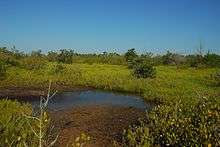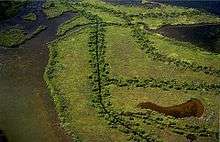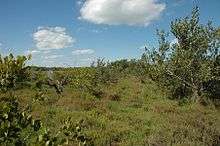Thousand Islands (Cocoa Beach)
The Thousand Islands are a group of natural, modified, and spoil islands in the Banana River Lagoon, Cocoa Beach, in Brevard County, Florida. From the late 1950s to the early 1970s the islands were reshaped by development and efforts to control mosquitoes as the population of Brevard grew during the initial period of the space program at Cape Canaveral and Kennedy Space Center.
History
The State of Florida bought the Thousand Islands in 1988. It leased them back to the City of Cocoa Beach in 1991, providing that the islands be used for recreation and conservational efforts. The total price was $3,230,950. The city contributed $1,615,475, Brevard County contributed $700,000, and the State of Florida contributed $915,475.[1]
Geomorphology
Sediment cores reveal that the Thousand Islands were formed when a storm-driven sea broke through the barrier island, leaving behind an approximately 900 acres (360 ha) flood tide delta deposit. The date of this event is unknown. Charts from the mid 19th century and older do not depict the Thousand Islands. However, this might be due to lack of detail. The Cocoa Beach area was surveyed in 1876-1877 and appears identical to the 1951 aerial photographs.
The stratigraphic characteristics of a flood tide delta deposit include the existence of a layer of plain sand (often containing terrestrial vegetation debris) sandwiched between sediments containing numerous small bivalve mollusc shells that are indicative of deposition in a normal lagoon environment.[2] This uneven sand layer lacking shells suggests an interruption in the normal accretion of benthic sediments by a rapid deposition of dune material being washed in by severe wave action.
There are about 100 islands in the Thousand Islands,[3] The actual number of islands is meaningless due to the inundation of many areas during seasonal high water during summer. The relatively low topography and rising water levels can turn one island into many as rains begin.
The Thousand Islands are divided roughly in half by the Minutemen Causeway. The formation comprises approximately 900 acres (360 ha) of salt marsh, mangroves, spoil sites containing upland vegetation, and maritime hammocks on shell middens.[4] Beginning in the late 1950s, small ditches were dug through the islands to allow water movement and fish access to inner areas of the succulent marsh for mosquito control.[5]
At approximately the same time, dredge and fill activities were begun in Cocoa Beach for housing development. Developers dredged canals and used the spoil to provide fill material for houses. Several areas of the Thousand Islands were filled but not fully developed, leaving large areas of uplands. During the late 1960s Brevard County Mosquito Control began dredging the Thousand Islands south of Minutemen Causeway, resulting in conversion of salt marsh to upland dredge spoil with the state-owned C-34 impoundment.[6]





Flora
Native wetlands are dominated by red, black, and white mangroves.[7] Succulent marsh contains saltwort, annual glasswort, perennial glasswort,[8] sea blight,[9] and shoreline seapurslane.
The transition zone between salt marsh and upland is dominated by bushy seaside oxeye (Borrichia frutescens (L.) DC.) and buttonwood (Conocarpus erectus L.). Transition areas dominated by graminoid vegetation contain saltgrass (Distichlis spicata (L.) Greene) and seashore paspalum (Paspalum vaginatum Sw.).
Uplands have been colonized by several native plant species, including Florida swamp privet (Forestiera segregata (Jacq.) Krug & Urb.), salt bush (Baccharis halimifolia L.), cabbage palm (Sabal palmetto (Walter) Lodd. ex Shult. & Schult. f.), wax myrtle (Myrica cerifera L.), and strangler fig (Ficus aurea Nutt.).
Principal invasive non-native plants include Brazilian pepper (Schinus terebinthifolius Raddi), Australian pines (Casuarina equisetifolia L., Casuarina glauca Sieber ex Spreng.), and carrotwood (Cupaniopsis anacardioides (A. Rich.) Radlk.). All are Category I invasives, "...altering native plant communities by displacing native species, changing community structures or ecological functions..." [10]
Pre-Columbian shell middens are present in four main areas of the Thousand Islands. Quantitative work done on the Provost and Salmela middens in the south Islands by Kozusko & Hunt[11] has found the following tropical plant species: marlberry (Ardisia escallonioides Schiede & Deppe ex Schltdl. & Cham.), torchwood (Amyris elemifera L.), gumbo limbo (Bursera simaruba (L.) Sarg.), bay-leaf capertree (Capparis flexuosa (L.) L.), Jamaican capertree (Capparis jamaicensis Jacq.), snowberry (Chiococca alba (L.) Hitchc.), pigeonplumb (Coccoloba diversifolia Jacq.), seagrape (Coccoloba uvifera (L.) L.), coralbean (Erythrina herbacea L.), Spanish stopper (Eugenia foetida Pers.), white stopper (Eugenia axillaris (Sw.) Willd.), blolly (Guapira discolor (Spreng.) Little), black ironwood (Krugiodendron ferreum(Vahl) Urb.), twinberry (Myrcianthes fragrans(Sw.) McVaugh), white indigo-berry (Randia aculeata L.), saffron plumb (Sideroxylon celastrinum(Kunth) T. D. Penn.), and wild lime (Zanthoxylum fagara (L.) Sarg.). Many of these plants are not found farther north than Brevard County.
Acquisition, Restoration
The state of Florida and Cocoa Beach purchased the islands north of Minutemen Causeway in 1988. Acquisition of the remaining south islands was completed by 2007. These islands are managed as the Thousand Islands Conservation Area by Brevard County Environmentally Endangered Lands Program. Efforts to acquire the remaining privately held islands began in 2006 with acquisition of the Reynolds tract, and were completed in 2007 with acquisition of the Crawford Homes tract by the Brevard County Environmentally Endangered Lands Program (EEL).[12]
Restoration efforts involve removal of Brazilian pepper and Australian pine. Despite the Category I status of Australian pine,[13] removal of trees in ecological restoration can be controversial among the lay public.[14] In the EEL-managed Thousand Islands Conservation Area, replanting has been used following removal of Australian pine, but the effects are modest, with native recruitment out-pacing planted species.[15] The management plan for the north Thousand Islands is currently (April 2013) under revision.
References
- ↑ North Thousand Islands Management Plan
- ↑ Cooper, J. (1997). Lagoons and Microtidal Coasts. In: R. Carter and C. Woodroffe (editors) Coastal Evolution, Late Quaternary Shoreline Morphodynamics. Cambridge University Press. pp. 219–265. ISBN 9780521598903.
- ↑ Kozusko, Tim (August 2012). "Vegetation of the Thousand Islands". Unpublished manuscript.
- ↑ Kozusko, Tim. "Thousand Islands". Website. Retrieved December 2009. Check date values in:
|access-date=(help) - ↑ Salmela, Jack (2000). "Former Director, Brevard County Mosquito Control". Personal Communication.
- ↑ Beidler, John (2011). "Former Director, Indian River Mosquito Control District". Personal Communication.
- ↑ C.F. Gaertn
- ↑ (Mill.) A. J. Scott
- ↑ Elliott) Moq.
- ↑ Florida Exotic Pest Plant Council. "Invasive Plant Lists". Retrieved 14 April 2013.
- ↑ Kozusko, Tim; D. Hunt (2013). "Vegetation of Shell Middens in Thousand Islands, Brevard County, Florida". Manuscript to be submitted for publication.
- ↑ Knight, Mike (2011). "Director Brevard County EEL". Personal Communication.
- ↑ Florida Exotic Pest Plant Council. "Invasive Plant Lists". Retrieved 14 April 2013.
- ↑ Shore, D. (1997). "Controversy erupts over restoration in Chicago Area". Restoration and Management Notes. 15 (1): 25–31.
- ↑ Kozusko, Tim; S. Taylor (2013). "An Evaluation of a Vegetation Restoration in Thousand Islands, Brevard County, Florida". Manuscript to be submitted for publication.
External references
Plant nomenclature follows Wunderlin, R. P. & B. F. Hansen. (2011). Guide to the Vascular Plants of Florida, 3rd Edition. University Press of Florida, Gainesville.
External links
Coordinates: 28°19′22″N 80°37′41″W / 28.3227845°N 80.6281073°W